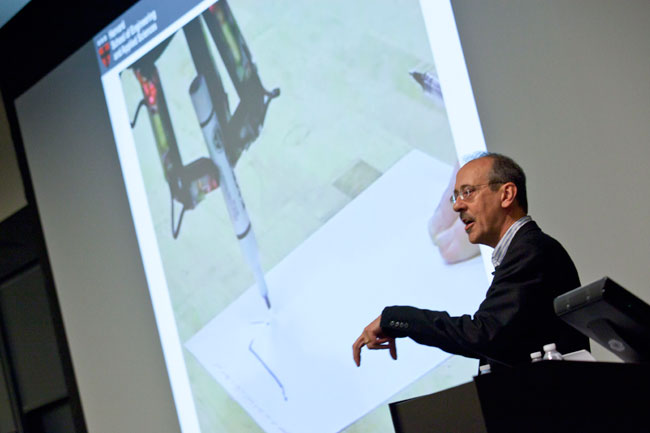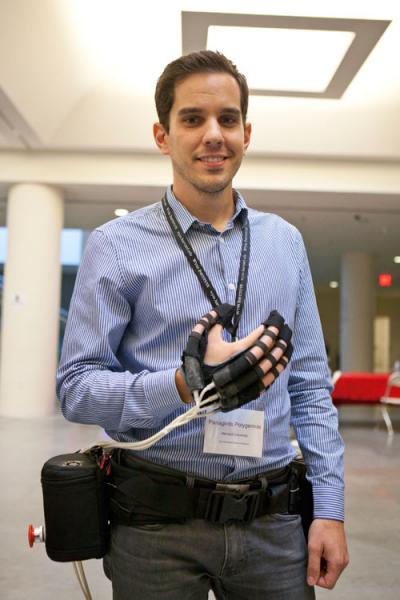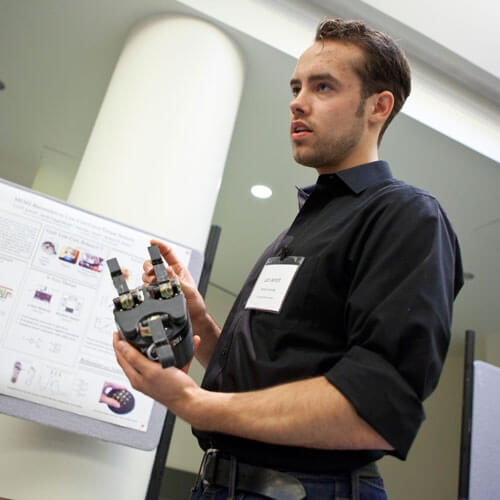News
Leif Jentoft, a Ph.D. student in the Harvard Biorobotics Lab at SEAS, demonstrates the i-HY robotic hand. This new device can grasp and manipulate a wide range of objects and is known for its precision fingertip grasps. (Photo by Eliza Grinnell, SEAS Communications.)

Robert D. Howe, Abbott and James Lawrence Professor of Engineering at Harvard SEAS, describes the state of the art of robotic grasping. (Photo by Eliza Grinnell, SEAS Communications.)
In the past, robots were designed for factories. Americans became upset when they lost jobs on the production line to mechanized arms that could do more work in less time — without salaries, health insurance, sick days, or vacations. Robots were big and clunky. Humans were kept away from them.
Today, that’s rapidly changing. New robot systems are soft and safe to be around, and even can be wearable. Robotics has never looked so people-friendly.
 Panagiotis Polygerinos, a postdoctoral fellow at the Wyss Institute for Biologically Inspired Engineering at Harvard, models one of Prof. Conor Walsh's next-generation soft, wearable robots, developed to assist both the disabled and able bodied. This hand increases the wearer's grip strength. (Photo by Eliza Grinnell.)
Panagiotis Polygerinos, a postdoctoral fellow at the Wyss Institute for Biologically Inspired Engineering at Harvard, models one of Prof. Conor Walsh's next-generation soft, wearable robots, developed to assist both the disabled and able bodied. This hand increases the wearer's grip strength. (Photo by Eliza Grinnell.)
In keeping with the changing times and attitudes, more than 200 people representing 18 companies and 20 universities from as far south as Washington, D.C., and as far west as Michigan attended the sold-out Second Annual Northeast Robotics Colloquium at Harvard last weekend.
Conor Walsh, assistant professor of mechanical and biomedical engineering at the School of Engineering and Applied Sciences (SEAS), is one of the pioneers of this new robotic world, and he presented his work to the conference.
Demonstrating the soft exosuit he has been developing, Walsh said, “We are designing robots specifically for people.” It’s a “totally different way than what people have done for 50 years,” he said.
Walsh’s exosuits are designed to be worn, and thus are pliable and moveable, with no resistance in movement. Walsh said the exosuit involves “smart interfacing with the body and smart ways to send information,” and enables the wearer to walk with less muscle activation. That might sound relaxing, but it’s not about being lazy. The exosuit has medical, military, and recreational applications. For instance, a recovering stroke patient could don the suit to help to restore his or her level of muscle function, allowing a better integration back into the community.
The research, funded by the Defense Advanced Research Projects Agency (DARPA), is especially useful for the military. Soldiers carry heavy loads for long periods. The suit “delays the onset of fatigue and protects the joints from injury,” by taking on a portion of the stress and movement from its wearer, Walsh said.
The suit can help people who have trouble moving, but cannot help people with paralysis.
Walsh and his team of Harvard faculty, grad students, postdocs, and research staff also developed a “soft disposable elastomeric robot” — in layman’s terms, a robotic cast that provides physical therapy while patients recover from injury...
Read the entire article in the Harvard Gazette
Topics: Robotics, Health / Medicine, Electrical Engineering, Computer Science, Bioengineering
Cutting-edge science delivered direct to your inbox.
Join the Harvard SEAS mailing list.
Scientist Profiles
Robert D. Howe
Abbott and James Lawrence Professor of Engineering




